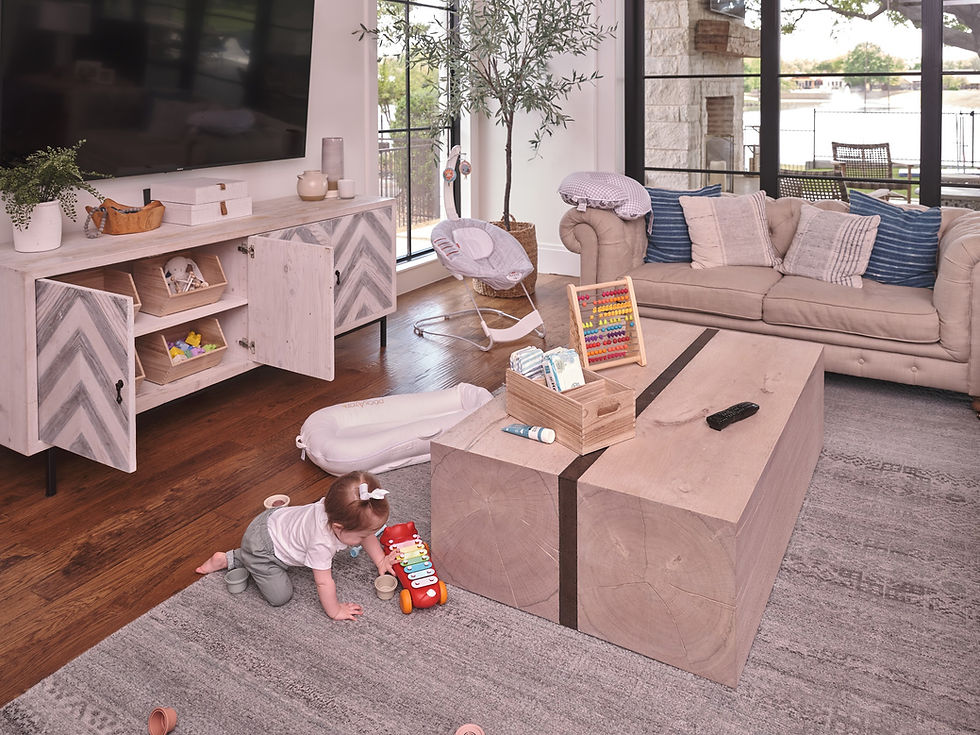Make Room for Baby -- And Their Stuff
- Marni Jameson

- Nov 6, 2023
- 4 min read

If necessity is the mother of invention, motherhood is the inventor of organization. Anyone who’s become a parent knows that if you thought keeping your house and life pulled together before kids was tough, lookout Baby! Here comes chaos.
When my two were born, two years apart, I went a good four years without matching earrings. Although nothing can prepare you for the upheaval, Ría Safford’s new book, “The Organized Home for New Parents: Create Routine-Ready Spaces for Your Baby's First Years,” out this month from Blue Star Press, gives new parents a running start.
The Dallas mother of three, ages 8, 6 and 4, Safford left a corporate job when her first child was born and started her organizing company that year. “This did not come easy,” she said. “I’m a naturally messy person, but I couldn’t keep flying by the seat of my pants.”
Her experience inspired her not only to start a business, but also to write a guide to organizing for expecting parents and those in the beginning stages of raising young kids. The result is a 252-page richly photographed hardcover that targets the years between newborn and two.
It’s a time like no other, thank goodness.
“Everything else about babies, from the pregnancy on, is really out of our control, but this book is about what you can control,” she said.
What her book is not is “one more preachy book,” she said. “Moms are already getting it from every direction on all the ways they’re doing it wrong. It’s more girlfriend guide. I took my mistakes and moments and wrote about them. If I’d had this book when I started having kids, my husband and I would have had a lot fewer arguments.”
Besides figuring out each partner’s roles and expectations, here are a few more suggestions Safford offers parents to soften the baby blow:
· Get ahead of the stuff. “Most expectant parents don’t realize their home’s inventory is going to triple,” Safford said. “These small humans come with so many things: bouncy chairs, sensory toys, cribs, travel chairs, car seats, strollers, diaper bags, clothes, and then the incoming gifts.” (It’s like they troll through Babies R Us with a fishing net and a magnet.) Have a plan for where it all will go (and what you can regift).
· Don’t make the nursery a storage area. Many parents get a baby item and think, “Oh, this is for the baby, we’ll put it in the nursery.” All baby items don’t belong in the nursery. The nursery should have only what you need for the baby’s current stage. Separate infant wear from clothes the child will grow into. Put the larger items, washed and ready to wear, in bins labeled by age (12-18 months, 2T). Store these bins in another room, the garage, or on a high shelf in the nursery, but not the most accessible areas. Keep the nursery current, uncluttered, and functional.
· Master the change. The goal when setting up a changing table is to make those 2 a.m. diaper changes as easy as possible. Organize this hard-working surface so you can reach everything you need in the dark when you’re half asleep. Keep the top of the changing table stocked only with essentials: diapers in the current size, wipes, cream, a toy to amuse baby while you’re changing, a diaper disposal in easy reach. In the drawers below store clean onesies, pajamas, swaddling blankets, and crib sheets for those major blowouts.
· Manage the inventory. Label drawers and shelves, too, (0–3-month onesies, swaddle blankets, and zip-up sleepers) so everyone who cares for the baby can easily find items and put them away. Prioritize what’s current. Have a system for regularly moving clothes out. Keep a too-small bin in the baby’s closet. As clothes stop fitting, drop those still in good condition in the bin. When you reach the top, that’s your cue to store the items (if you plan on another child), give them to a friend, or donate them.
· Have a catchall basket. Outside the nursery, baby stuff has a way of taking over. The family living area may start the day in order, but by 4 pm it’s a hurricane of blankets, rattles, baby books, toys, teeny socks, teething rings, mini shoes, and Goldfish crackers. To reclaim the space (and your sanity), keep a big basket in the main living area and drop all the randoms items in it to put away later (in their labeled places).
· Rotate toys as they age out. Just as with outgrown clothes, when kids outgrow certain toys, store them for the next baby or give them away. Otherwise, trust me, they will take over your house. If the child is just bored with certain toys, buy not ready to say good-bye, rotate them.
· Entertainment centers. Anyone who has had a baby knows, accomplishing anything beyond baby care is a feat. The solution is having an area in every room to safely entertain the baby while you cook, get dressed, or do laundry. A low cupboard in the kitchen with toys, for instance, or a bin of toys under the bathroom sink can buy precious minutes.
· Help tots pitch in. Around 16-18 months babies start to understand the concept of cleaning up, Safford said. (They do? Some never learn, I’m convinced.) Help them help by making clean up fun and easy. Play favorite songs and instead of words, use pictures of toy cars or dolls on bin labels.
· Purge often. Continually move things out and in as your child grows, which happens fast. Don’t be that 60-year-old grandmother who still has her child’s first burp cloth, and who hung onto the crib, car seat and highchair. They wouldn’t meet today’s safety standards anyway.
CAPTION: And Baby Makes —A Mess! In her new book, The Organized Home for New Parents, Dallas home organizer and mom Ría Safford offers solutions for managing all the stuff that babies come with, so homes with little ones function better and look good, too. Photo courtesy of Kristen Kilpatrick




Comments